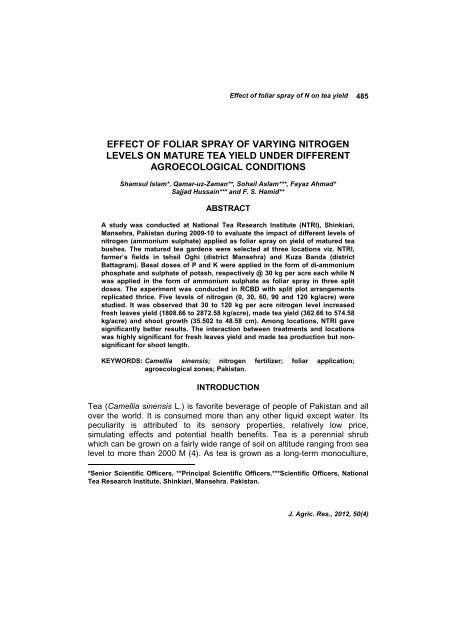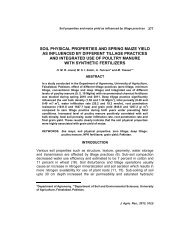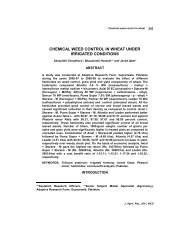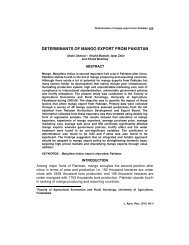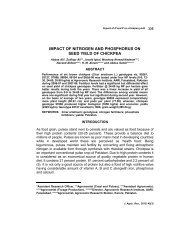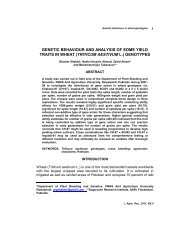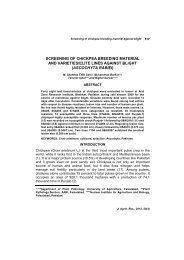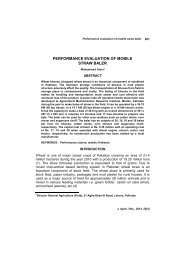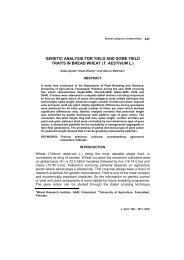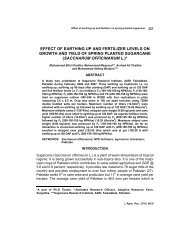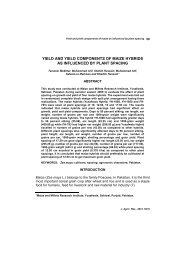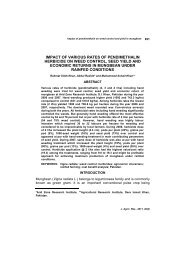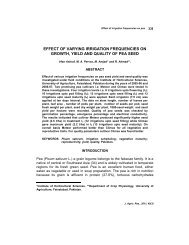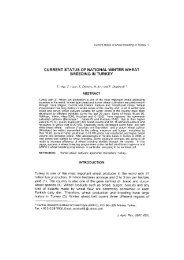effect of foliar spray of varying nitrogen levels on mature tea yield ...
effect of foliar spray of varying nitrogen levels on mature tea yield ...
effect of foliar spray of varying nitrogen levels on mature tea yield ...
Create successful ePaper yourself
Turn your PDF publications into a flip-book with our unique Google optimized e-Paper software.
Effect <str<strong>on</strong>g>of</str<strong>on</strong>g> <str<strong>on</strong>g>foliar</str<strong>on</strong>g> <str<strong>on</strong>g>spray</str<strong>on</strong>g> <str<strong>on</strong>g>of</str<strong>on</strong>g> N <strong>on</strong> <strong>tea</strong> <strong>yield</strong><br />
485<br />
EFFECT OF FOLIAR SPRAY OF VARYING NITROGEN<br />
LEVELS ON MATURE TEA YIELD UNDER DIFFERENT<br />
AGROECOLOGICAL CONDITIONS<br />
Shamsul Islam*, Qamar-uz-Zaman**, Sohail Aslam***, Fayaz Ahmad*<br />
Sajjad Hussain*** and F. S. Hamid**<br />
ABSTRACT<br />
A study was c<strong>on</strong>ducted at Nati<strong>on</strong>al Tea Research Institute (NTRI), Shinkiari,<br />
Mansehra, Pakistan during 2009-10 to evaluate the impact <str<strong>on</strong>g>of</str<strong>on</strong>g> different <str<strong>on</strong>g>levels</str<strong>on</strong>g> <str<strong>on</strong>g>of</str<strong>on</strong>g><br />
<str<strong>on</strong>g>nitrogen</str<strong>on</strong>g> (amm<strong>on</strong>ium sulphate) applied as <str<strong>on</strong>g>foliar</str<strong>on</strong>g> <str<strong>on</strong>g>spray</str<strong>on</strong>g> <strong>on</strong> <strong>yield</strong> <str<strong>on</strong>g>of</str<strong>on</strong>g> <strong>mature</strong>d <strong>tea</strong><br />
bushes. The <strong>mature</strong>d <strong>tea</strong> gardens were selected at three locati<strong>on</strong>s viz. NTRI,<br />
farmer’s fields in tehsil Oghi (district Mansehra) and Kuza Banda (district<br />
Battagram). Basal doses <str<strong>on</strong>g>of</str<strong>on</strong>g> P and K were applied in the form <str<strong>on</strong>g>of</str<strong>on</strong>g> di-amm<strong>on</strong>ium<br />
phosphate and sulphate <str<strong>on</strong>g>of</str<strong>on</strong>g> potash, respectively @ 30 kg per acre each while N<br />
was applied in the form <str<strong>on</strong>g>of</str<strong>on</strong>g> amm<strong>on</strong>ium sulphate as <str<strong>on</strong>g>foliar</str<strong>on</strong>g> <str<strong>on</strong>g>spray</str<strong>on</strong>g> in three split<br />
doses. The experiment was c<strong>on</strong>ducted in RCBD with split plot arrangements<br />
replicated thrice. Five <str<strong>on</strong>g>levels</str<strong>on</strong>g> <str<strong>on</strong>g>of</str<strong>on</strong>g> <str<strong>on</strong>g>nitrogen</str<strong>on</strong>g> (0, 30, 60, 90 and 120 kg/acre) were<br />
studied. It was observed that 30 to 120 kg per acre <str<strong>on</strong>g>nitrogen</str<strong>on</strong>g> level increased<br />
fresh leaves <strong>yield</strong> (1808.66 to 2872.58 kg/acre), made <strong>tea</strong> <strong>yield</strong> (362.66 to 574.58<br />
kg/acre) and shoot growth (35.502 to 48.58 cm). Am<strong>on</strong>g locati<strong>on</strong>s, NTRI gave<br />
significantly better results. The interacti<strong>on</strong> between treatments and locati<strong>on</strong>s<br />
was highly significant for fresh leaves <strong>yield</strong> and made <strong>tea</strong> producti<strong>on</strong> but n<strong>on</strong>significant<br />
for shoot length.<br />
KEYWORDS: Camellia sinensis; <str<strong>on</strong>g>nitrogen</str<strong>on</strong>g> fertilizer; <str<strong>on</strong>g>foliar</str<strong>on</strong>g> applicati<strong>on</strong>;<br />
agroecological z<strong>on</strong>es; Pakistan.<br />
INTRODUCTION<br />
Tea (Camellia sinensis L.) is favorite beverage <str<strong>on</strong>g>of</str<strong>on</strong>g> people <str<strong>on</strong>g>of</str<strong>on</strong>g> Pakistan and all<br />
over the world. It is c<strong>on</strong>sumed more than any other liquid except water. Its<br />
peculiarity is attributed to its sensory properties, relatively low price,<br />
simulating <str<strong>on</strong>g>effect</str<strong>on</strong>g>s and potential health benefits. Tea is a perennial shrub<br />
which can be grown <strong>on</strong> a fairly wide range <str<strong>on</strong>g>of</str<strong>on</strong>g> soil <strong>on</strong> altitude ranging from sea<br />
level to more than 2000 M (4). As <strong>tea</strong> is grown as a l<strong>on</strong>g-term m<strong>on</strong>oculture,<br />
*Senior Scientific Officers, **Principal Scientific Officers,***Scientific Officers, Nati<strong>on</strong>al<br />
Tea Research Institute, Shinkiari, Mansehra. Pakistan.<br />
J. Agric. Res., 2012, 50(4)
486<br />
S. Islam et al.<br />
fertilizati<strong>on</strong> plays a vital role for its ec<strong>on</strong>omic producti<strong>on</strong>. B<strong>on</strong>heure and<br />
Wills<strong>on</strong> (2) reported that without fertilizer applicati<strong>on</strong> supply <str<strong>on</strong>g>of</str<strong>on</strong>g> nutrients<br />
available in the soil would become exhausted leading to mineral deficiencies<br />
in plants, severe reducti<strong>on</strong> in <strong>yield</strong> and ultimately death <str<strong>on</strong>g>of</str<strong>on</strong>g> plants. They also<br />
found that <str<strong>on</strong>g>nitrogen</str<strong>on</strong>g> is very important for plant growth and is present in the<br />
most important substances (e.g. chlorophyll, nucleotides, horm<strong>on</strong>es,<br />
protoplasm, vitamins, etc.) in the plant. Besides, stem and older leaves also<br />
take 50 kg N, 12 kg P and 32 kg K. Weeds growing in <strong>tea</strong> field also absorb<br />
substantial quantity <str<strong>on</strong>g>of</str<strong>on</strong>g> nutrients and if not removed from the fields, result in<br />
permanent loss. The removal <str<strong>on</strong>g>of</str<strong>on</strong>g> nutrients thus, has to be compensated by<br />
their external applicati<strong>on</strong>. Rojoa et al. (17) revealed that the highest <strong>tea</strong> <strong>yield</strong>s<br />
in Mauritius were obtained with applicati<strong>on</strong> <str<strong>on</strong>g>of</str<strong>on</strong>g> 375 kg N per hectare per<br />
annum. Rikhter and Lyashko (16) found in Russia that <strong>yield</strong>s <str<strong>on</strong>g>of</str<strong>on</strong>g> <strong>tea</strong> were<br />
higher with 300 kg N as compared to 450-600 kg N per hectare. Malenga (9)<br />
observed a linear resp<strong>on</strong>se to <str<strong>on</strong>g>nitrogen</str<strong>on</strong>g> <strong>on</strong> cl<strong>on</strong>es in Malawi upto 250 kg N per<br />
hectare. Malenga (10) found that the resp<strong>on</strong>se fell below the linear increase<br />
at <str<strong>on</strong>g>nitrogen</str<strong>on</strong>g> rates <str<strong>on</strong>g>of</str<strong>on</strong>g> 250 kg per hectare. Zaman et al. (23) found that<br />
<str<strong>on</strong>g>nitrogen</str<strong>on</strong>g>ous fertilizer @ 375 kg per hectare increased fresh leaves <strong>yield</strong>,<br />
made <strong>tea</strong> producti<strong>on</strong> and plant height significantly. The <str<strong>on</strong>g>effect</str<strong>on</strong>g>s <str<strong>on</strong>g>of</str<strong>on</strong>g> cultural<br />
practices, soil characteristics and fertilizer applicati<strong>on</strong> <strong>on</strong> <str<strong>on</strong>g>nitrogen</str<strong>on</strong>g> uptake<br />
have also been observed by Karasuyama et al. (7).<br />
Foliar applicati<strong>on</strong> <str<strong>on</strong>g>of</str<strong>on</strong>g> fertilizers is the most <str<strong>on</strong>g>effect</str<strong>on</strong>g>ive way to increase <strong>yield</strong> and<br />
plant health. Experiments have shown that <str<strong>on</strong>g>foliar</str<strong>on</strong>g> feeding can increase <strong>yield</strong><br />
from 12 to 25 percent when compared to c<strong>on</strong>venti<strong>on</strong>al fertilizati<strong>on</strong>. Foliar<br />
fertilizers are widely used in vegetable and fruit crops, that c<strong>on</strong>tain various<br />
macro and micro-nutrients essential for proper growth and <strong>yield</strong>. Foliar<br />
fertilizer technology came into use early in this century, but did not become<br />
more comm<strong>on</strong> practice. After 1980s, <str<strong>on</strong>g>foliar</str<strong>on</strong>g> applicati<strong>on</strong> <str<strong>on</strong>g>of</str<strong>on</strong>g> fertilizers has been<br />
c<strong>on</strong>sidered as the quickest way to deliver nutrients to tissues and organs <str<strong>on</strong>g>of</str<strong>on</strong>g><br />
the crop, and it has also been proved that applicati<strong>on</strong> <str<strong>on</strong>g>of</str<strong>on</strong>g> these micro-nutrients<br />
is beneficial to correct certain nutrient deficiencies (1).<br />
Foliar feeding is the practice <str<strong>on</strong>g>of</str<strong>on</strong>g> applying liquid fertilizers to plant leaves. The<br />
leaves are green factories where the complex chemical processes <str<strong>on</strong>g>of</str<strong>on</strong>g><br />
photosynthesis produce the compounds, needed for plant growth. Foliar<br />
fertilizers are absorbed right at the site where these are used as quite fast<br />
acting, whereas much <str<strong>on</strong>g>of</str<strong>on</strong>g> soil fertilizers may never go to plants. Silberbush<br />
(18) stated that <str<strong>on</strong>g>foliar</str<strong>on</strong>g> fertilizati<strong>on</strong> is widely used to correct nutriti<strong>on</strong>al<br />
deficiencies in plants caused by improper supply <str<strong>on</strong>g>of</str<strong>on</strong>g> nutrients to roots. Ca and<br />
B which are immobile in the plant should be applied in small amounts at high<br />
J. Agric. Res., 2012, 50(4)
Effect <str<strong>on</strong>g>of</str<strong>on</strong>g> <str<strong>on</strong>g>foliar</str<strong>on</strong>g> <str<strong>on</strong>g>spray</str<strong>on</strong>g> <str<strong>on</strong>g>of</str<strong>on</strong>g> N <strong>on</strong> <strong>tea</strong> <strong>yield</strong><br />
487<br />
frequency rather than in <strong>on</strong>e applicati<strong>on</strong> for correcting temporary deficiencies<br />
in vegetables. Naruka and Singh (13) applied two c<strong>on</strong>centrati<strong>on</strong>s <str<strong>on</strong>g>of</str<strong>on</strong>g> urea<br />
<str<strong>on</strong>g>spray</str<strong>on</strong>g> (1 and 2%) and three c<strong>on</strong>centrati<strong>on</strong>s (50, 100 and 150 ppm) <str<strong>on</strong>g>of</str<strong>on</strong>g><br />
gibberellic acid <str<strong>on</strong>g>spray</str<strong>on</strong>g> (GA3). Both urea and gibberellic acid applicati<strong>on</strong><br />
enhanced the growth and fruit <strong>yield</strong> <str<strong>on</strong>g>of</str<strong>on</strong>g> okra significantly. Tumbare et al. (21)<br />
applied NPK at recommended rate as solid fertilizer and as liquid fertilizer.<br />
Yield and <strong>yield</strong> comp<strong>on</strong>ent values increased with increasing fertilizer rate by<br />
liquid as compared to c<strong>on</strong>venti<strong>on</strong>al applicati<strong>on</strong>. Souza et al. (20) applied<br />
kumulus (c<strong>on</strong>taining sulfur) at 4 kg per hectare to see the <str<strong>on</strong>g>effect</str<strong>on</strong>g> <strong>on</strong> cott<strong>on</strong><br />
crop. Treatments with increased sulfur produced 11.5 percent more cott<strong>on</strong><br />
seed than untreated c<strong>on</strong>trol. Selvi and Rani (19) treated okra plants with<br />
NPK (40: 50: 30 kg/ha) al<strong>on</strong>e, NPK + micr<strong>on</strong>utrients (MNS; soil applicati<strong>on</strong> <str<strong>on</strong>g>of</str<strong>on</strong>g><br />
FeSO4 at 50 kg/ha and ZnSO 4 at 25 kg/ha, or <str<strong>on</strong>g>foliar</str<strong>on</strong>g> <str<strong>on</strong>g>spray</str<strong>on</strong>g> <str<strong>on</strong>g>of</str<strong>on</strong>g> FeSO 4 at 1.0%<br />
and ZnSO 4 at 0.5%) or <str<strong>on</strong>g>foliar</str<strong>on</strong>g> and soil applicati<strong>on</strong> <str<strong>on</strong>g>of</str<strong>on</strong>g> micro-food (SMF, 750<br />
and 25 kg/ha), respectively. They recorded the highest <strong>yield</strong>, income and<br />
benefit cost ratio from NPK+SMF and MNS <str<strong>on</strong>g>foliar</str<strong>on</strong>g> treatment; whereas, the<br />
lowest <strong>yield</strong> was recorded from single NPK treatment.<br />
A soil survey <str<strong>on</strong>g>of</str<strong>on</strong>g> prospective <strong>tea</strong> growing areas <str<strong>on</strong>g>of</str<strong>on</strong>g> northern parts <str<strong>on</strong>g>of</str<strong>on</strong>g> KPK was<br />
c<strong>on</strong>ducted by Chinese <strong>tea</strong> experts in 1982 and followed up again in 1988.<br />
About 60,000 hectares <str<strong>on</strong>g>of</str<strong>on</strong>g> land were identified as suitable for <strong>tea</strong> cultivati<strong>on</strong> in<br />
Mansehra and Swat districts <str<strong>on</strong>g>of</str<strong>on</strong>g> KPK based <strong>on</strong> topography, soil and climatic<br />
data (14). The prospective <strong>tea</strong> growing areas <str<strong>on</strong>g>of</str<strong>on</strong>g> Pakistan are located at<br />
altitudes ranging from 1000-2000 m with <str<strong>on</strong>g>varying</str<strong>on</strong>g> soil pH ranging from 5.0-6.5.<br />
Here the annual rainfall is more than 1000 mm with annual average<br />
temperature ranging from 10.7-22.8 0 C. About 600 acres area in districts<br />
Mansehra, Battagram and Swat has been brought under <strong>tea</strong> plantati<strong>on</strong> by<br />
Nati<strong>on</strong>al Tea Research Institute, Shinkiari, Mansehra.<br />
The present study was designed to find out the most <str<strong>on</strong>g>effect</str<strong>on</strong>g>ive and<br />
ec<strong>on</strong>omical dose <str<strong>on</strong>g>of</str<strong>on</strong>g> amm<strong>on</strong>ium sulphate applied by <str<strong>on</strong>g>foliar</str<strong>on</strong>g> <str<strong>on</strong>g>spray</str<strong>on</strong>g> method for<br />
maximum <strong>tea</strong> <strong>yield</strong> under different agro-climatic c<strong>on</strong>diti<strong>on</strong>s <str<strong>on</strong>g>of</str<strong>on</strong>g> Mansehra and<br />
Battagram districts.<br />
MATERIALS AND METHODS<br />
This study was c<strong>on</strong>ducted at Nati<strong>on</strong>al Tea Research Institute, Shinkiari,<br />
Mansehra, Pakistan during 2009-10. Matured <strong>tea</strong> gardens (cv. Qi-Men) were<br />
selected at three locati<strong>on</strong>s i.e. NTRI, farmer’s fields in tehsil Oghi (district<br />
Mansehra) and Kuza Banda (district Battagram). Nitrogen was applied by<br />
<str<strong>on</strong>g>foliar</str<strong>on</strong>g> applicati<strong>on</strong> method in the form <str<strong>on</strong>g>of</str<strong>on</strong>g> amm<strong>on</strong>ium sulphate at five <str<strong>on</strong>g>levels</str<strong>on</strong>g> (0,<br />
30, 60, 90, and 120 kg N/acre). The P and K were kept at c<strong>on</strong>stant level <str<strong>on</strong>g>of</str<strong>on</strong>g><br />
J. Agric. Res., 2012, 50(4)
488<br />
S. Islam et al.<br />
30 kg per acre. The sources <str<strong>on</strong>g>of</str<strong>on</strong>g> nutrients P and K were di-amm<strong>on</strong>ium<br />
phosphate (DAP) and sulphate <str<strong>on</strong>g>of</str<strong>on</strong>g> potash (SOP), respectively. The<br />
experiments were laid out in RCBD with split plot arrangements by placing<br />
<str<strong>on</strong>g>nitrogen</str<strong>on</strong>g> treatments in main plot and locati<strong>on</strong>s as sub-plots. Plot size was<br />
kept as three rows, 1.2 meter wide and 5 meter l<strong>on</strong>g. Full doses <str<strong>on</strong>g>of</str<strong>on</strong>g> P and K<br />
were applied as a basal dose while N was applied in three split doses during<br />
March, July and September dissolving the required quantity <str<strong>on</strong>g>of</str<strong>on</strong>g> fertilizer in<br />
water to make <strong>on</strong>e percent c<strong>on</strong>centrati<strong>on</strong> (12). All agr<strong>on</strong>omic practices like<br />
weeding, irrigati<strong>on</strong> and pruning were kept uniform and plucking was d<strong>on</strong>e<br />
manually by keeping two leaves and a bud as standard. Data regarding fresh<br />
leaves <strong>yield</strong>, made <strong>tea</strong> producti<strong>on</strong> and shoot growth were recorded and<br />
analyzed statistically using MSTAT-C package. Treatment differences were<br />
calculated by using least significant difference (LSD) test.<br />
Table 1. Analysis <str<strong>on</strong>g>of</str<strong>on</strong>g> variance for various traits at different locati<strong>on</strong>s and <str<strong>on</strong>g>nitrogen</str<strong>on</strong>g> <str<strong>on</strong>g>levels</str<strong>on</strong>g><br />
<strong>on</strong> <strong>yield</strong> and growth <str<strong>on</strong>g>of</str<strong>on</strong>g> <strong>tea</strong>.<br />
Source <str<strong>on</strong>g>of</str<strong>on</strong>g> variance Df F value<br />
Fresh leaves <strong>yield</strong><br />
(kg/acre)<br />
Made <strong>tea</strong><br />
producti<strong>on</strong><br />
(kg/acre)<br />
J. Agric. Res., 2012, 50(4)<br />
Shoot growth<br />
(cm)<br />
Nitrogen <str<strong>on</strong>g>levels</str<strong>on</strong>g>(N) 4 105.68** 101.64** 124.66**<br />
Error 12 -- -- --<br />
Locati<strong>on</strong>s(L) 2 395.82** 405.62** 45.07**<br />
Interacti<strong>on</strong> (N x L) 8 6.57* 6.88** 1.34NS<br />
Error 30 -- -- --<br />
* Significant, **Highly significant, NS = N<strong>on</strong>-significant<br />
Fresh leaves <strong>yield</strong><br />
RESULTS AND DISCUSSION<br />
The data (Table 2) indicated that increased <str<strong>on</strong>g>nitrogen</str<strong>on</strong>g> <str<strong>on</strong>g>levels</str<strong>on</strong>g> increased the<br />
fresh leaves <strong>yield</strong> significantly at all three locati<strong>on</strong>s. Am<strong>on</strong>g the <str<strong>on</strong>g>nitrogen</str<strong>on</strong>g><br />
<str<strong>on</strong>g>levels</str<strong>on</strong>g>, N 5 produced significantly higher fresh leaves <strong>yield</strong> (2872.58 kg/acre)<br />
followed by N 4 (2557.83 kg/acre) and N 3 (2348.08 kg/acre). However, the<br />
lowest fresh leaves <strong>yield</strong> (1808.66 kg/acre) was recorded in c<strong>on</strong>trol<br />
treatment. Am<strong>on</strong>g locati<strong>on</strong>s, significantly higher fresh leaves <strong>yield</strong> (2989.33<br />
kg/acre) was recorded at NTRI. The fresh leaves <strong>yield</strong> at Battagram and<br />
Oghi was at par (Table 2). In case <str<strong>on</strong>g>of</str<strong>on</strong>g> interacti<strong>on</strong> between fertilizer <str<strong>on</strong>g>levels</str<strong>on</strong>g> and<br />
locati<strong>on</strong>s, N 5 L 1 (120 kg N at NTRI) produced significantly higher fresh leaves<br />
<strong>yield</strong> (3768.50 kg/acre) followed by N 4 L 1 (3282.25 kg/acre) and N 3 L 1 (2981.50<br />
kg/acre). Minimum fresh leaves <strong>yield</strong> was recorded in N 1 L 3 (1592.50 kg/acre).<br />
These results are similar to the findings <str<strong>on</strong>g>of</str<strong>on</strong>g> Rikhter and Lyashko (16) who<br />
obtained higher <strong>yield</strong> from 300 kg N per hectare. Zaman et al. (23) also
Effect <str<strong>on</strong>g>of</str<strong>on</strong>g> <str<strong>on</strong>g>foliar</str<strong>on</strong>g> <str<strong>on</strong>g>spray</str<strong>on</strong>g> <str<strong>on</strong>g>of</str<strong>on</strong>g> N <strong>on</strong> <strong>tea</strong> <strong>yield</strong><br />
489<br />
Table 2. Effect <str<strong>on</strong>g>of</str<strong>on</strong>g> different <str<strong>on</strong>g>levels</str<strong>on</strong>g> <str<strong>on</strong>g>of</str<strong>on</strong>g> <str<strong>on</strong>g>nitrogen</str<strong>on</strong>g> applied as <str<strong>on</strong>g>foliar</str<strong>on</strong>g> <str<strong>on</strong>g>spray</str<strong>on</strong>g> <strong>on</strong> <strong>yield</strong> <str<strong>on</strong>g>of</str<strong>on</strong>g><br />
<strong>mature</strong>d <strong>tea</strong> under different agro-ecological c<strong>on</strong>diti<strong>on</strong>s.<br />
Treatments<br />
Fresh leaves<br />
<strong>yield</strong><br />
(kg/acre)<br />
Made <strong>tea</strong><br />
producti<strong>on</strong><br />
(kg/acre)<br />
Shoot<br />
length/growth<br />
(cm)<br />
Nitrogen <str<strong>on</strong>g>levels</str<strong>on</strong>g>(kg/acre)<br />
N 1=0 (c<strong>on</strong>trol) 1808.66 e 362.66 e 35.50 e<br />
N 2=30 2121.16 d 424.91 d 38.41 d<br />
N 3=60 2348.08 c 469.58 c 42.66 c<br />
N 4=90 2557.83b 511.33 b 45.75 b<br />
N 5=120 2872.58 a 574.58 a 48.58 a<br />
LSD value at 5% 121.80 24.73 1.84<br />
Locati<strong>on</strong>s(L)<br />
L 1 = NTRI 2989.33 a 597.85 a 48.00 a<br />
L 2 = Battagram 2043.55 b 409.25 b 36.55 c<br />
L 3 = Oghi 1993.95 b 398.75 b 39.60 b<br />
Interacti<strong>on</strong> (N x L)<br />
N 1x L 1 2199.0f 439.76f 35.75<br />
N 1x L 2 1634.50i 329.75 i 26.75<br />
N 1x L 3 1592.50i 318.50 i 32.00<br />
N 2x L 1 2715.25 d 543.25 d 42.00<br />
N 2x L 2 1884.00 gh 377.00 gh 35.75<br />
N 2x L 3 1773.25 hi 35 7.5hi 37.50<br />
N 3x L 1 2981.50 c 596.25 c 50.50<br />
N 3x L 2 2041.75fg 408.25fg 37.50<br />
N 3x L 3 2021.00fg 404.25fg 40.00<br />
N 4 x L 1 3282.25 b 656.25 b 55.00<br />
N 4x L 2 2199.25 f 439.50 f 39.75<br />
N 4x L 3 2192.00 f 438.25 f 42.50<br />
N 5x L 1 3768.50 a 753.75 a 56.75<br />
N 5x L 2 2458.25 e 491.75 e 43.00<br />
N 5x L 3 2391.00 e 478.25 e 46.00<br />
LSD value at 5% 182.10 35.93 NS<br />
Means followed by different letter(s) within each column differ significantly (P=0.05)<br />
NS = N<strong>on</strong>-significant.<br />
reported maximum fresh leaves <strong>yield</strong> (8797 kg/ha) when <str<strong>on</strong>g>nitrogen</str<strong>on</strong>g> was<br />
applied @ 375 kg per hectare. Ishigaki (5) showed that <strong>tea</strong> absorbed<br />
amm<strong>on</strong>ium <str<strong>on</strong>g>nitrogen</str<strong>on</strong>g> more <str<strong>on</strong>g>effect</str<strong>on</strong>g>ively than nitrate <str<strong>on</strong>g>nitrogen</str<strong>on</strong>g>.<br />
Made <strong>tea</strong> producti<strong>on</strong><br />
Black <strong>tea</strong> was made involving withering, rolling, CTC, fermentati<strong>on</strong> and drying<br />
process at <strong>tea</strong> processing plant <str<strong>on</strong>g>of</str<strong>on</strong>g> NTRI .The data (Table 2) revealed that<br />
<str<strong>on</strong>g>nitrogen</str<strong>on</strong>g> applicati<strong>on</strong> increased made <strong>tea</strong> producti<strong>on</strong> significantly at all N<br />
<str<strong>on</strong>g>levels</str<strong>on</strong>g>. Maximum made <strong>tea</strong> (574.58 kg/acre) was obtained from N 5 treatment,<br />
followed by N 4 (511.33 kg/acre) and N 3 (469.58 kg/acre). Minimum <strong>tea</strong><br />
producti<strong>on</strong> (362.66 kg/acre) was recorded from c<strong>on</strong>trol treatment. Am<strong>on</strong>g<br />
locati<strong>on</strong>s NTRI produced higher <strong>tea</strong> (597.85 kg/acre) than Battagram (409.25<br />
J. Agric. Res., 2012, 50(4)
490<br />
S. Islam et al.<br />
kg/acre) and Oghi (398.75 kg/acre). However, difference in made <strong>tea</strong><br />
producti<strong>on</strong> between Battagram and Oghi was n<strong>on</strong>-significant (P=0.05). These<br />
results are in c<strong>on</strong>formity with those <str<strong>on</strong>g>of</str<strong>on</strong>g> earlier scientists (21) who reported that<br />
<strong>yield</strong> and <strong>yield</strong> comp<strong>on</strong>ent values increased with increasing fertilizer rate by<br />
liquid as compared to c<strong>on</strong>venti<strong>on</strong>al applicati<strong>on</strong>. Krishnapillai and Ediriweera<br />
(8) reported that increasing <str<strong>on</strong>g>levels</str<strong>on</strong>g> <str<strong>on</strong>g>of</str<strong>on</strong>g> <str<strong>on</strong>g>nitrogen</str<strong>on</strong>g> and potassium fertilizers<br />
increased the chlorophyll c<strong>on</strong>tent <str<strong>on</strong>g>of</str<strong>on</strong>g> <strong>tea</strong> leaves, which could increase the<br />
blackness <str<strong>on</strong>g>of</str<strong>on</strong>g> <strong>tea</strong>.<br />
Although 120 kg N al<strong>on</strong>gwith 30 kg P and K per acre each applied by <str<strong>on</strong>g>foliar</str<strong>on</strong>g><br />
<str<strong>on</strong>g>spray</str<strong>on</strong>g> method produced higher <strong>tea</strong> <strong>yield</strong>, yet the difference in <strong>yield</strong> obtained<br />
from NTRI, Battagram and Oghi may be due to difference in weather<br />
c<strong>on</strong>diti<strong>on</strong>s <str<strong>on</strong>g>of</str<strong>on</strong>g> the area. Growth is comparatively slow in Battagram and Oghi,<br />
due to cold and dry weather as temperature may be as low as zero. Slow<br />
growth and lower temperature favour quality <strong>tea</strong> producti<strong>on</strong> (3). There is well<br />
distributed rainfall and uniform temperature at NTRI for most <str<strong>on</strong>g>of</str<strong>on</strong>g> the year<br />
resulting in an even growth and cropping, producing higher <strong>yield</strong> with inferior<br />
quality.<br />
Shoot length/growth<br />
The data (Table 2) revealed that shoot length <str<strong>on</strong>g>of</str<strong>on</strong>g> <strong>tea</strong> increased significantly<br />
with increasing <str<strong>on</strong>g>levels</str<strong>on</strong>g> <str<strong>on</strong>g>of</str<strong>on</strong>g> N fertilizer at all locati<strong>on</strong>s. N 5 produced maximum<br />
shoot length (48.58cm) followed by N 4 (45.75cm) and N 3 (42.66 cm).<br />
Treatment receiving no fertilizer (N 1 ) produced minimum shoot length<br />
(35.50cm). Am<strong>on</strong>g locati<strong>on</strong>s, maximum shoot growth (48.00 cm) was<br />
recorded at L 1 (NTRI) followed by L 3 (Oghi) (39.60 cm) and L 2 (Battagram)<br />
(36.55 cm). The interacti<strong>on</strong> <str<strong>on</strong>g>effect</str<strong>on</strong>g> between N <str<strong>on</strong>g>levels</str<strong>on</strong>g> and locati<strong>on</strong>s was n<strong>on</strong>significant.<br />
However, N 5 L 1 (120 kg N at NTRI) gave more shoot length (56.75<br />
cm). Similar results were reported by Ventakaramani (22) who studied the<br />
<str<strong>on</strong>g>effect</str<strong>on</strong>g> <str<strong>on</strong>g>of</str<strong>on</strong>g> amm<strong>on</strong>ium sulphate <strong>on</strong> shoot length and number <str<strong>on</strong>g>of</str<strong>on</strong>g> roots in <strong>tea</strong><br />
plant. He found significant increase in shoot length, number <str<strong>on</strong>g>of</str<strong>on</strong>g> lateral roots<br />
and size <str<strong>on</strong>g>of</str<strong>on</strong>g> roots when amm<strong>on</strong>ium sulphate was applied to the soil surface @<br />
2g per pot as a dilute soluti<strong>on</strong>.<br />
J. Agric. Res., 2012, 50(4)<br />
CONCLUSION<br />
The study c<strong>on</strong>cluded that applicati<strong>on</strong> <str<strong>on</strong>g>of</str<strong>on</strong>g> amm<strong>on</strong>ium sulphate (120 kg N/acre)<br />
when applied by <str<strong>on</strong>g>foliar</str<strong>on</strong>g> <str<strong>on</strong>g>spray</str<strong>on</strong>g> method al<strong>on</strong>gwith 30 kg P and K per acre<br />
produced higher fresh leaves <strong>yield</strong> and made <strong>tea</strong>. In case <str<strong>on</strong>g>of</str<strong>on</strong>g> locati<strong>on</strong>s, higher<br />
fresh leaves <strong>yield</strong> and made <strong>tea</strong> was recorded at Nati<strong>on</strong>al Tea Research<br />
Institute, Shinkiari. In case <str<strong>on</strong>g>of</str<strong>on</strong>g> interacti<strong>on</strong>, 120 kg N at NTRI (N 5 xL 1 ) excelled<br />
significantly in fresh leaves <strong>yield</strong> (3768.50 kg/acre) and made <strong>tea</strong> (753.75<br />
kg/acre).
Effect <str<strong>on</strong>g>of</str<strong>on</strong>g> <str<strong>on</strong>g>foliar</str<strong>on</strong>g> <str<strong>on</strong>g>spray</str<strong>on</strong>g> <str<strong>on</strong>g>of</str<strong>on</strong>g> N <strong>on</strong> <strong>tea</strong> <strong>yield</strong><br />
491<br />
REFERENCES<br />
1. An<strong>on</strong>. 2001. Foliar Fertilizers Vegetrain 01-01. A Vegetables Crops Ext.<br />
Pub. <str<strong>on</strong>g>of</str<strong>on</strong>g> Florida. www.hos.ufl.edu/vegetari<strong>on</strong>. Date <str<strong>on</strong>g>of</str<strong>on</strong>g> download: 05-10-<br />
2004.<br />
2. B<strong>on</strong>heure, D. and K. C. Wills<strong>on</strong>. 1992. Tea cultivati<strong>on</strong> to c<strong>on</strong>sumpti<strong>on</strong>.<br />
Mineral Nutriti<strong>on</strong> and Fertilizers. Champman and Hall, 2-6 Boundry<br />
Row, L<strong>on</strong>d<strong>on</strong>. p. 268-271.<br />
3. Goswani, M.R. and B.C. Barbora. 1994. Chemical factors influencing<br />
seas<strong>on</strong>al quality <str<strong>on</strong>g>of</str<strong>on</strong>g> cl<strong>on</strong>al <strong>tea</strong>s. Proc. Chem. Soc. 612:12-16.<br />
4. Hamid, F.S., N. Ahmad, A. Waheed and A. Rauf. 1993. The mineral<br />
status and physical compositi<strong>on</strong> <str<strong>on</strong>g>of</str<strong>on</strong>g> prospective <strong>tea</strong> growing areas <str<strong>on</strong>g>of</str<strong>on</strong>g><br />
NWFP. Sarhad J. Agric. 9:608-614.<br />
5. Ishigaki, K. 1978. Studies <strong>on</strong> the nutritive characteristics <str<strong>on</strong>g>of</str<strong>on</strong>g> <strong>tea</strong> plant.<br />
Bulletin <str<strong>on</strong>g>of</str<strong>on</strong>g> Nati<strong>on</strong>al Research Institute <str<strong>on</strong>g>of</str<strong>on</strong>g> Tea (Japan). 40:152.<br />
6. Jiskani, M. M. 2002. Foliar fertilizers, www.pakissan.com.<br />
7. Karasuyama, N., T. Y<strong>on</strong>eyama and H. Kobayashi. 1985. 15 N study <strong>on</strong><br />
the fate <str<strong>on</strong>g>of</str<strong>on</strong>g> <str<strong>on</strong>g>foliar</str<strong>on</strong>g>ly applied urea <str<strong>on</strong>g>nitrogen</str<strong>on</strong>g> in <strong>tea</strong> plant. Soil Sci. and Pl.<br />
Nut. 31(1):123-131.<br />
8. Krishnapillai, S. and V. L. Ediriweera. 1986. Influence <str<strong>on</strong>g>of</str<strong>on</strong>g> <str<strong>on</strong>g>levels</str<strong>on</strong>g> <str<strong>on</strong>g>of</str<strong>on</strong>g><br />
<str<strong>on</strong>g>nitrogen</str<strong>on</strong>g> and potassium fertilizers <strong>on</strong> chlorophyll c<strong>on</strong>tent in <strong>mature</strong><br />
cl<strong>on</strong>al <strong>tea</strong> leaves. Sri Lanka J. Tea Sci. 55(2):71-76.<br />
9. Malenga, N.E.A. 1985. Resp<strong>on</strong>se <str<strong>on</strong>g>of</str<strong>on</strong>g> young cl<strong>on</strong>al <strong>tea</strong> to <str<strong>on</strong>g>nitrogen</str<strong>on</strong>g>.<br />
Quarterly Newsletter. Tea Research Foundati<strong>on</strong> (Central Africa). 79:7.<br />
10. Malenga, N.E.A. 1987. The <str<strong>on</strong>g>effect</str<strong>on</strong>g> <str<strong>on</strong>g>of</str<strong>on</strong>g> different <str<strong>on</strong>g>levels</str<strong>on</strong>g> <str<strong>on</strong>g>of</str<strong>on</strong>g> <str<strong>on</strong>g>nitrogen</str<strong>on</strong>g> <strong>on</strong> the<br />
<strong>yield</strong>, quality and value <str<strong>on</strong>g>of</str<strong>on</strong>g> made <strong>tea</strong> from cl<strong>on</strong>es in agr<strong>on</strong>omy trials.<br />
Quarterly NL. Tea Research Foundati<strong>on</strong> (Central Africa) 82:7-11.<br />
11. Maynard, D. and G. Hochmuth. 1996. Handbook for Vegetable<br />
Growers. 4th Ed. John Willey & S<strong>on</strong>s, Inc. www.pakistan.com<br />
12. Meskhidze, A.M. 1985. The <str<strong>on</strong>g>effect</str<strong>on</strong>g>s <str<strong>on</strong>g>of</str<strong>on</strong>g> forms <str<strong>on</strong>g>of</str<strong>on</strong>g> <str<strong>on</strong>g>nitrogen</str<strong>on</strong>g> fertilizers <strong>on</strong><br />
the productivity <str<strong>on</strong>g>of</str<strong>on</strong>g> <strong>tea</strong> plants. Subtropicheskie Kul’tury. 5:55-58.<br />
13. Naruka, B.S. and I. S. L. Singh. 1998. Effect <str<strong>on</strong>g>of</str<strong>on</strong>g> <str<strong>on</strong>g>foliar</str<strong>on</strong>g> applicati<strong>on</strong> <str<strong>on</strong>g>of</str<strong>on</strong>g><br />
<str<strong>on</strong>g>nitrogen</str<strong>on</strong>g> (urea) and gibberellic acid (GA3) <strong>on</strong> growth and <strong>yield</strong> <str<strong>on</strong>g>of</str<strong>on</strong>g> okra<br />
(Abelmoschus esculentus L. Moench) cv. Pusa Sawani. Progressive<br />
Hort. 30 (3/4): 175-180.<br />
14. Nathaniel, R.K. 1992. Tea Development in Pakistan. FAO Missi<strong>on</strong><br />
Report. Rome, Italy.<br />
15. Palaniappan, S. P., A. Jeyabal and S. Chelliah. 1999. Resp<strong>on</strong>se <str<strong>on</strong>g>of</str<strong>on</strong>g><br />
tomato and chili to <str<strong>on</strong>g>foliar</str<strong>on</strong>g> applicati<strong>on</strong> <str<strong>on</strong>g>of</str<strong>on</strong>g> specialty fertilizers. Vegetable<br />
Sci. 26 (20): 198-200.<br />
16. Rikhter, M.A. and M.U. Lyashko. 1979. The <str<strong>on</strong>g>effect</str<strong>on</strong>g> <str<strong>on</strong>g>of</str<strong>on</strong>g> high <str<strong>on</strong>g>nitrogen</str<strong>on</strong>g> rates<br />
<strong>on</strong> the <strong>yield</strong> and quality <str<strong>on</strong>g>of</str<strong>on</strong>g> irrigated <strong>tea</strong>. Subtropicheskie Kul’tury. 1:36-<br />
43.<br />
J. Agric. Res., 2012, 50(4)
492<br />
S. Islam et al.<br />
17. Rojoa, H., K. Ramdaursingh and A.M. Ouradally. 1979. Fertilizati<strong>on</strong> <str<strong>on</strong>g>of</str<strong>on</strong>g><br />
<strong>mature</strong> <strong>tea</strong> plants. Revue Agricole et Sucriére de l’lle Maurice,<br />
58(3):147-152.<br />
18. Silberbush, L. F. 2002. Resp<strong>on</strong>se <str<strong>on</strong>g>of</str<strong>on</strong>g> maize to <str<strong>on</strong>g>foliar</str<strong>on</strong>g> vs. soil applicati<strong>on</strong><br />
<str<strong>on</strong>g>of</str<strong>on</strong>g> <str<strong>on</strong>g>nitrogen</str<strong>on</strong>g>-phosphorus-potassium fertilizers. J. Pl. Nut. 25 (11): 2333-<br />
2342.<br />
19. Selvi, D. and P. Rani. 2000. Effect <str<strong>on</strong>g>of</str<strong>on</strong>g> integrated nutrient management<br />
<strong>on</strong> <strong>yield</strong> and ec<strong>on</strong>omics <str<strong>on</strong>g>of</str<strong>on</strong>g> okra in an inceptisol. Vegetable Sci. 27 (2):<br />
207-208.<br />
20. Souza, E. C. A, A. Borgo, M. Scatolin and A. C. C. Santos. 1999. Foliar<br />
fertilizing with sulfur in cott<strong>on</strong>. Anais II C<strong>on</strong>gresso Brasileiro de<br />
Algodao. p. 411-413.<br />
21. Tumbare, A. D., B. N. Shinde and S. U. Bhoite. 1999. Effect <str<strong>on</strong>g>of</str<strong>on</strong>g> liquid<br />
fertilizer through drip irrigati<strong>on</strong> <strong>on</strong> growth and <strong>yield</strong> <str<strong>on</strong>g>of</str<strong>on</strong>g> okra (Hibiscus<br />
esculentus). Indian J. Agr<strong>on</strong>. 44 (1): 176-176.<br />
22. Ventakaramani, K.S. 1962. Effect <str<strong>on</strong>g>of</str<strong>on</strong>g> amm<strong>on</strong>ium sulphate <strong>on</strong> shoot<br />
length and number <str<strong>on</strong>g>of</str<strong>on</strong>g> roots per <strong>tea</strong> cutting. A.R.U.A.S.I Sci.Dept. Tea<br />
Secti<strong>on</strong>. 88-9.<br />
23. Zaman, Q., S. Sarwar, F. Ahmad and F.S. Hamid. 2011. Effect <str<strong>on</strong>g>of</str<strong>on</strong>g><br />
<str<strong>on</strong>g>nitrogen</str<strong>on</strong>g>ous fertilizer <strong>on</strong> the growth and <strong>yield</strong> <str<strong>on</strong>g>of</str<strong>on</strong>g> <strong>tea</strong> (Camellia sinensis<br />
L.) pruned in curved vs flat shape. J. Agric. Res. 49(4):477-482.<br />
J. Agric. Res., 2012, 50(4)


